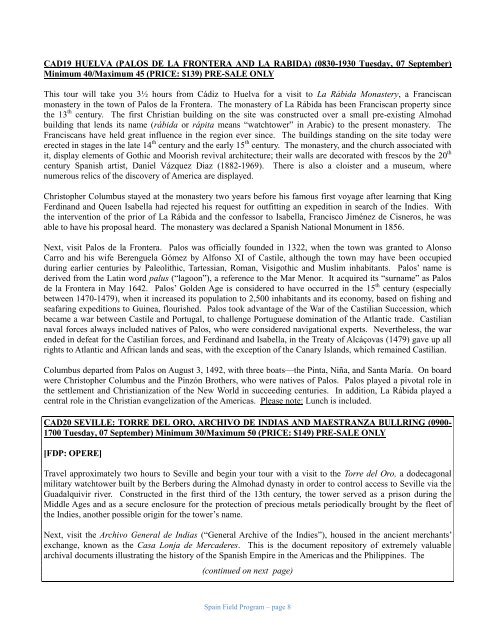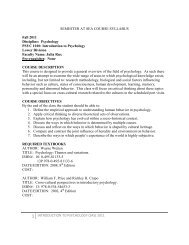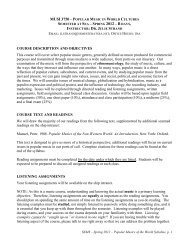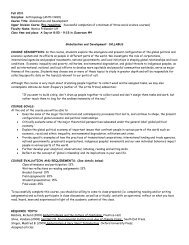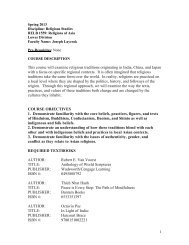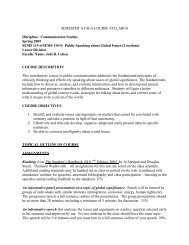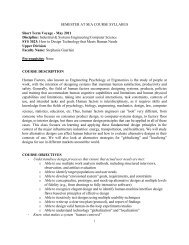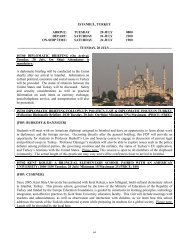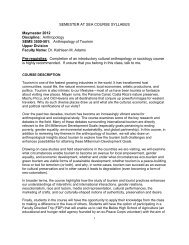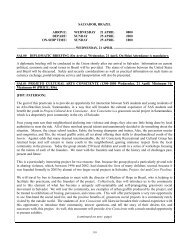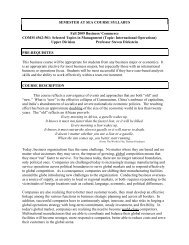Final Field Program - University of Virginia
Final Field Program - University of Virginia
Final Field Program - University of Virginia
You also want an ePaper? Increase the reach of your titles
YUMPU automatically turns print PDFs into web optimized ePapers that Google loves.
CAD19 HUELVA (PALOS DE LA FRONTERA AND LA RABIDA) (0830-1930 Tuesday, 07 September)<br />
Minimum 40/Maximum 45 (PRICE: $139) PRE-SALE ONLY<br />
This tour will take you 3½ hours from Cádiz to Huelva for a visit to La Rábida Monastery, a Franciscan<br />
monastery in the town <strong>of</strong> Palos de la Frontera. The monastery <strong>of</strong> La Rábida has been Franciscan property since<br />
the 13 th century. The first Christian building on the site was constructed over a small pre-existing Almohad<br />
building that lends its name (rábida or rápita means ―watchtower‖ in Arabic) to the present monastery. The<br />
Franciscans have held great influence in the region ever since. The buildings standing on the site today were<br />
erected in stages in the late 14 th century and the early 15 th century. The monastery, and the church associated with<br />
it, display elements <strong>of</strong> Gothic and Moorish revival architecture; their walls are decorated with frescos by the 20 th<br />
century Spanish artist, Daniel Vázquez Diaz (1882-1969). There is also a cloister and a museum, where<br />
numerous relics <strong>of</strong> the discovery <strong>of</strong> America are displayed.<br />
Christopher Columbus stayed at the monastery two years before his famous first voyage after learning that King<br />
Ferdinand and Queen Isabella had rejected his request for outfitting an expedition in search <strong>of</strong> the Indies. With<br />
the intervention <strong>of</strong> the prior <strong>of</strong> La Rábida and the confessor to Isabella, Francisco Jiménez de Cisneros, he was<br />
able to have his proposal heard. The monastery was declared a Spanish National Monument in 1856.<br />
Next, visit Palos de la Frontera. Palos was <strong>of</strong>ficially founded in 1322, when the town was granted to Alonso<br />
Carro and his wife Berenguela Gómez by Alfonso XI <strong>of</strong> Castile, although the town may have been occupied<br />
during earlier centuries by Paleolithic, Tartessian, Roman, Visigothic and Muslim inhabitants. Palos’ name is<br />
derived from the Latin word palus (―lagoon‖), a reference to the Mar Menor. It acquired its ―surname‖ as Palos<br />
de la Frontera in May 1642. Palos’ Golden Age is considered to have occurred in the 15 th century (especially<br />
between 1470-1479), when it increased its population to 2,500 inhabitants and its economy, based on fishing and<br />
seafaring expeditions to Guinea, flourished. Palos took advantage <strong>of</strong> the War <strong>of</strong> the Castilian Succession, which<br />
became a war between Castile and Portugal, to challenge Portuguese domination <strong>of</strong> the Atlantic trade. Castilian<br />
naval forces always included natives <strong>of</strong> Palos, who were considered navigational experts. Nevertheless, the war<br />
ended in defeat for the Castilian forces, and Ferdinand and Isabella, in the Treaty <strong>of</strong> Alcáçovas (1479) gave up all<br />
rights to Atlantic and African lands and seas, with the exception <strong>of</strong> the Canary Islands, which remained Castilian.<br />
Columbus departed from Palos on August 3, 1492, with three boats—the Pinta, Niña, and Santa María. On board<br />
were Christopher Columbus and the Pinzón Brothers, who were natives <strong>of</strong> Palos. Palos played a pivotal role in<br />
the settlement and Christianization <strong>of</strong> the New World in succeeding centuries. In addition, La Rábida played a<br />
central role in the Christian evangelization <strong>of</strong> the Americas. Please note: Lunch is included.<br />
CAD20 SEVILLE: TORRE DEL ORO, ARCHIVO DE INDIAS AND MAESTRANZA BULLRING (0900-<br />
1700 Tuesday, 07 September) Minimum 30/Maximum 50 (PRICE: $149) PRE-SALE ONLY<br />
[FDP: OPERE]<br />
Travel approximately two hours to Seville and begin your tour with a visit to the Torre del Oro, a dodecagonal<br />
military watchtower built by the Berbers during the Almohad dynasty in order to control access to Seville via the<br />
Guadalquivir river. Constructed in the first third <strong>of</strong> the 13th century, the tower served as a prison during the<br />
Middle Ages and as a secure enclosure for the protection <strong>of</strong> precious metals periodically brought by the fleet <strong>of</strong><br />
the Indies, another possible origin for the tower’s name.<br />
Next, visit the Archivo General de Indias (―General Archive <strong>of</strong> the Indies‖), housed in the ancient merchants’<br />
exchange, known as the Casa Lonja de Mercaderes. This is the document repository <strong>of</strong> extremely valuable<br />
archival documents illustrating the history <strong>of</strong> the Spanish Empire in the Americas and the Philippines. The<br />
(continued on next page)<br />
Spain <strong>Field</strong> <strong>Program</strong> – page 8


